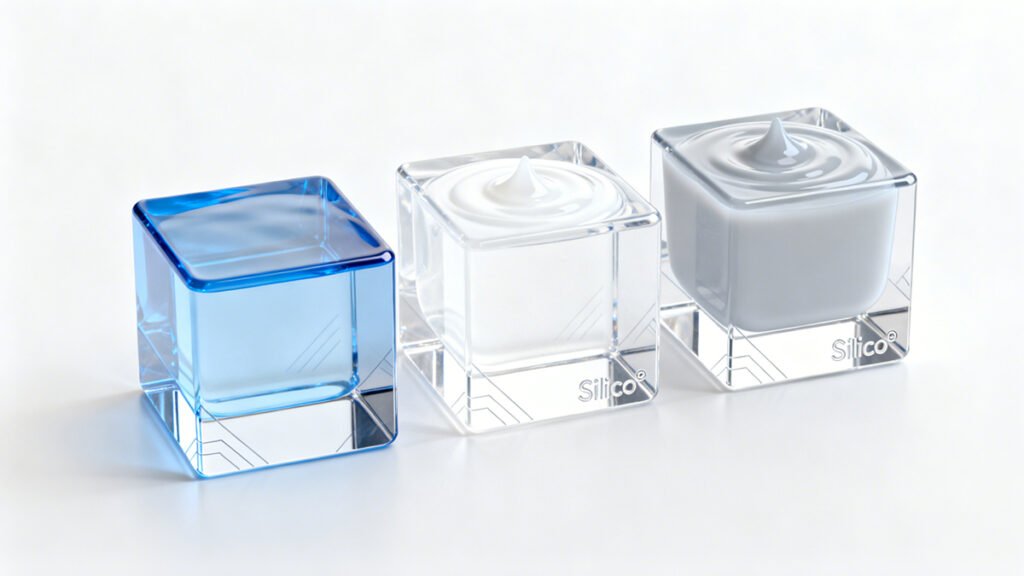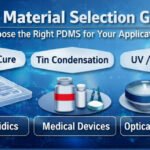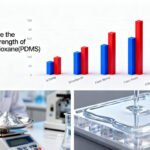How to Correctly Choose Medical-Grade Silicone Fluid
- Blog
- October 16, 2025
- 10:25 am
Medical devices and drug-delivery systems demand materials with exceptional purity, safety, and performance consistency. Medical-grade silicone fluids—mainly polydimethylsiloxane (PDMS)—are essential in medical lubricants, mold-release agents, siliconization processes, intraocular tamponades, and hydrophobic coatings.
Choosing the wrong silicone fluid grade or a non-certified industrial variant can result in device malfunctions, regulatory non-compliance, or patient safety incidents. In particular, for intraocular and implantable applications, only rigorously tested fluids—such as Silico® Medical-Grade Silicone Fluids—should be considered to ensure full biocompatibility and regulatory conformity.
Table of Contents
- 1. What “Medical-Grade Silicone Fluid” Means (Standards & Examples)
- 2. Key Performance & Safety Attributes to Evaluate
- 3. Regulatory & Biocompatibility Requirements (ISO 10993, FDA, USP)
- 4. Application-Driven Selection (Examples with Priorities)
- 5. Typical Grades, Viscosity Ranges, and Functional Trade-offs
- 6. Sterilization, Packaging, and Shelf-Life Considerations
- 7. Recommended Test Matrix (Lab + In-Device Verification)
- 8. Procurement & QC Checklist
- 9. Common Pitfalls & How to Avoid Them
- 10. Frequently Asked Questions (FAQ)
- 10. Conclusion & Selection Recommendations
1. What “Medical-Grade Silicone Fluid” Means (Standards & Examples)
- Manufactured under controlled contamination environments (e.g., ISO-class cleanrooms).
- Comprehensive batch-level documentation: CoA confirming purity, low heavy metals, residual solvent limits, and low-molecular-weight fractions.
- Clear regulatory declarations linking the product to its intended use (e.g., syringe siliconization, catheter lubrication, intraocular tamponade).
2. Key Performance & Safety Attributes to Evaluate
- Chemical purity & impurity profile — Verify through CoA (heavy metals, catalysts, residual siloxanes).
- Viscosity (cSt at 25°C) — Governs spreading, coating uniformity, and device lubrication behavior.
- Molecular weight distribution — Lower fractions increase migration and emulsification risks.
- Biocompatibility (ISO 10993) — Confirm cytotoxicity, irritation, sensitization, and systemic safety test results.
- Sterilizability & stability — Ensure the silicone remains stable under EtO, gamma, or autoclave sterilization.
Particulate & emulsification resistance — Essential for ophthalmic and injectable applications.
3. Regulatory & Biocompatibility Requirements (ISO 10993, FDA, USP)
The ISO 10993 series defines global standards for evaluating biological safety in medical device materials. Required endpoints depend on body contact type and duration (surface, mucosal, or implantable).
FDA Guidance: Specific silicone fluids, such as ophthalmic tamponade oils, have established FDA device precedents (510(k), PMA). Clinical performance and sterilization validation are required.
USP Standards: For pharmaceutical packaging and syringe applications, residual silicone levels, particulate content, and extractables must meet pharmacopeial thresholds.
Actionable Tip: Always map your device’s intended contact category to the appropriate ISO 10993 endpoints before finalizing a silicone fluid grade.
4. Application-Driven Selection (Examples with Priorities)
Syringe & Parenteral Siliconization
- Priority: Ultra-high purity, minimal low-Mw siloxanes, particulate-free.
- Best Practice: Use Silico® Ultra-Pure PDMS with documented drug-product compatibility and migration stability.
Catheter / Valve Lubrication
- Priority: Stable viscosity, low extractables, validated ISO 10993 biocompatibility, sterilization compatibility.
Ophthalmic Tamponade (Intraocular Use)
- Priority: Controlled viscosity (typically 1000–5000 cSt), clinically validated ophthalmic grade, minimized emulsification tendency.
Implant Coatings / Anti-Adhesion Layers
- Priority: Durable hydrophobic coating performance, migration resistance, complete ISO 10993-implant test matrix.


5. Typical Grades, Viscosity Ranges, and Functional Trade-offs
| Viscosity Range (cSt) | Typical Application | Key Trade-offs |
|---|---|---|
| 10–100 | Syringe lubrication, thin coatings | Easy spreading, higher migration |
| 100–1000 | General device lubrication | Balanced processability |
| 1000–5000 | Ophthalmic tamponades | High purity, low migration, harder to process |
Higher viscosity → reduced migration and volatility.
Lower viscosity → easier application but increased risk of migration or emulsification.
Silico® provides viscosity-stable medical silicone fluids across all these ranges.
6. Sterilization, Packaging, and Shelf-Life Considerations
Sterilization: Confirm resistance to EtO, gamma, or autoclave sterilization; some PDMS grades degrade under radiation.
Packaging: Must be in pharmacopeial-grade, sealed containers, with batch traceability and tamper-proof closures.
Shelf Life: Supplier should provide validated stability and storage condition data (typically 24–36 months).
7. Recommended Test Matrix (Lab + In-Device Verification)
A. Supplier Documentation
- TDS, MSDS, batch CoA
- ISO 9001 / ISO 13485 certification
- Clean manufacturing declarations
B. Laboratory Tests
- GC/MS — Low-molecular-weight siloxanes
- ICP-MS — Trace metals
- ASTM D445 — Viscosity
- TGA — Volatility and mass loss
- USP <788> — Particulate counts
C. Biocompatibility Testing (ISO 10993)
- Cytotoxicity, sensitization, irritation
- Systemic toxicity (if implantable or ophthalmic)
D. In-Device Validation
- Functional tests (lubrication, torque reduction, release)
- Migration studies in relevant simulants
- Emulsification testing (for ophthalmic applications)
8. Procurement & QC Checklist
- CoA (batch-specific) — includes viscosity, density, impurities, heavy metals
- ISO 10993 test data and FDA/USP compliance statement
- Sterilization compatibility declaration
Certificate of Origin and traceability
- Confirm lot conformity via viscosity check
- Verify storage and packaging integrity
- Conduct random particulate spot testing
9. Common Pitfalls & How to Avoid Them
| Pitfall | How to Avoid |
|---|---|
| Using non-medical PDMS without CoA | Always demand certified medical-grade PDMS from reputable brands like Silico® |
| Ignoring low-Mw fraction content | Review GC/MS and TGA results |
| Failing to test sterilization stability | Perform sterilization-stress validation |
| Overlooking particulate limits | Include USP particulate requirements in purchase contracts |
10. Frequently Asked Questions (FAQ)
A: No. Syringe siliconization requires ultra-pure, low-viscosity grades; intraocular tamponades use highly viscous ophthalmic-grade fluids with documented clinical safety.
A: Select high-purity, high-viscosity ophthalmic fluids (e.g., 1000–5000 cSt) and follow validated surgical techniques.
A: A batch-specific Certificate of Analysis (CoA) and any ISO 10993 biocompatibility reports related to your intended use.
11. References & Further Reading
- ISO 10993 Series — Biological Evaluation of Medical Devices
- FDA Medical Device Guidance on Silicone Oils and PDMS Materials
- USP <788> Particulate Matter in Injections
- Peer-reviewed ophthalmic silicone oil studies (PMC database)
- Silico® Technical Datasheets — Medical-Grade Silicone Fluids
Popular Recommendations
Get a Catalog & Best Price
- Quick and helpful reply within 24 hours;
- Tailored solutions provided for your project;
- One-stop purchasing service.
TRENDING
Silico® ORGANOSILICON
- Address: Daiyue Industrial Area, Taian, Shandong, China



